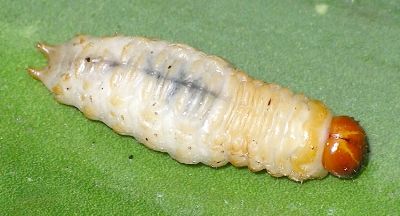by Valerie
April, 2004Agave Weevil
In terms of destructive capabilities, this 3/4 inch long grub is hard to beat. It is an agave beetle larva (Scyphophorus acupunctatus), and we managed to acquire a healthy population of these pests. The first sign that anything is amiss occurs when a large agave suddenly collapses as if wilting. This happened to one of four full-grown mescal agaves that we had planted on the front edges of our driveway. The plants had grown to about five feet across over a number of years and were quite dramatic in appearance. When I investigated the cause of the phenomenon, I discovered that the entire heart of the plant was rotted, and the huge, heavy leaves could be pulled right off. The rotted part had a particularly noxious odor and appeared brown and gooey. It also contained small black weevils and their white larvae. After the remains of the first agave were cleared out, two more plants fell victim within the next year. As of this writing, the last is infected but not completely dead yet. Until it rots out at the center, it is too big and tough to remove without a lot of effort. Fortunately, we have plenty of other plants to take over the vacant spots in the garden, and the weevils only attack agaves. Agave weevils damage the plants in several ways. The adults create tunnels through the leaves as they eat, and the females lay eggs within these holes. Once the grubs hatch, they feed on the new leaves at the center of the plant, which then usually becomes infected by bacteria. This is the source of the rancid smelling brown slime. The grubs seem to feed right in the brown mess and later pupate using plant fibers to create a cocoon. The adult beetles are about 5/8 of an inch long and black. While they are actually not very big, they are giants compared to most weevils. I have read that they don't have functional wings, and, although I've never seen one fly, I've also never examined an adult closely enough to see if it is true. The grubs resemble a cross between a maggot and a scarab grub. They have no legs and move about with a rippling motion of their body. The beetles killed the largest of one agave species but they have not attacked the smaller offshoots from those plants. They have infested a couple of lechuguilla (another species of agave) yet only destroyed one older plant so far. One of the most curious things that I've noticed is the effect on our variegated American agaves. These plants are less cold hardy and come from Florida, but they do pretty well for us in this area. The weevils' damage is evident in the form of holes through the leaves, especially as they are growing at the center, but so far none of the Florida plants has been infected with the center rot that befell the other species. |
(More information on agaves and weevils is available in "larvalbug's garden.")